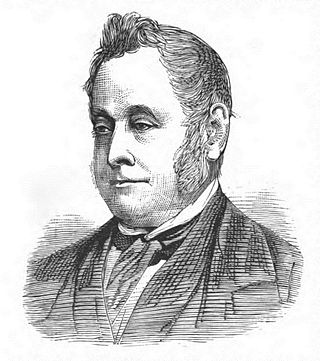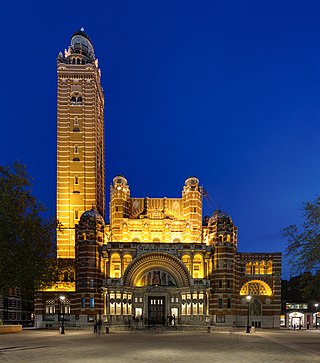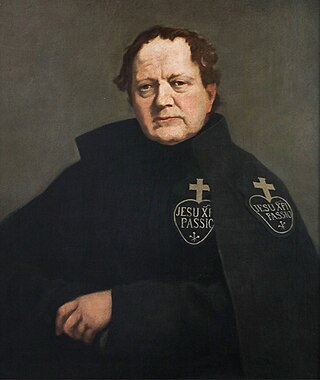
Anglo-Catholicism comprises beliefs and practices that emphasise the catholic heritage and identity of the various Anglican churches.

John Henry Newman was an English theologian, academic, philosopher, historian, writer, and poet, first as an Anglican priest and later as a Catholic priest and cardinal, who was an important and controversial figure in the religious history of England in the 19th century. He was known nationally by the mid-1830s, and was canonised as a saint in the Catholic Church in 2019.

Apologia Pro Vita Sua is John Henry Newman's history of his religious opinions, showing how his opinions had been formed and how they had led him from Anglicanism to the Catholic Church. It was originally published as a series of pamphlets in 1864 in response to an attack by Charles Kingsley against Newman's honesty. Though Newman's honesty had been widely questioned for years, the Apologia was immensely successful and cleared Newman's name. Newman published a revised version in 1865.

Ronald Arbuthnott Knox was an English Catholic priest, theologian, author, and radio broadcaster. Educated at Eton and Balliol College, Oxford, where he earned a high reputation as a classicist, Knox was ordained as a priest of the Church of England in 1912. He was a fellow and chaplain of Trinity College, Oxford until he resigned from those positions following his conversion to Catholicism in 1917. Knox became a Catholic priest in 1918, continuing in that capacity his scholarly and literary work.

William George Ward was an English theologian and mathematician. A Roman Catholic convert, his career illustrates the development of religious opinion at a time of crisis in the history of English religious thought.

The Oxford Movement was a movement of high church members of the Church of England which began in the 1830s and eventually developed into Anglo-Catholicism. The movement, whose original devotees were mostly associated with the University of Oxford, argued for the reinstatement of some older Christian traditions of faith and their inclusion into Anglican liturgy and theology. They thought of Anglicanism as one of three branches of the "one, holy, catholic, and apostolic" Christian church. Many key participants subsequently converted to Roman Catholicism.
The term high church refers to beliefs and practices of Christian ecclesiology, liturgy, and theology that emphasize "ritual, priestly authority, [and] sacraments". Although used in connection with various Christian traditions, the term originated in and has been principally associated with the Anglican tradition, where it describes churches using a number of ritual practices associated in the popular mind with Roman Catholicism and Eastern Orthodoxy. The opposite tradition is low church. Contemporary media discussing Anglican churches often prefer the terms evangelical to low church and Anglo-Catholic to high church, even though their meanings do not exactly correspond. Other contemporary denominations that contain high church wings include some Lutheran, Presbyterian, and Methodist churches.
A deathbed conversion is the adoption of a particular religious faith shortly before dying. Making a conversion on one's deathbed may reflect an immediate change of belief, a desire to formalize longer-term beliefs, or a desire to complete a process of conversion already underway. Claims of the deathbed conversion of famous or influential figures have also been used in history as rhetorical devices.
The Cambridge movement was a conservative ideological school of thought closely related to the Oxford Movement.

Sir Arnold Henry Moore Lunn was a skier, mountaineer and writer. He was knighted for "services to British Skiing and Anglo-Swiss relations" in 1952. His father was a lay Methodist minister, but Lunn was an agnostic and wrote critically about Catholicism before he converted to that religion at the age of 45 and became an apologist.
Burns & Oates was a British Roman Catholic publishing house which most recently existed as an imprint of Continuum.

William Lockhart was an English Roman Catholic priest; the first of the Tractarian Movement to convert from Anglicanism to Roman Catholicism.

The Catholic Church in England and Wales is part of the worldwide Catholic Church in full communion with the Holy See. Its origins date from the 6th century, when Pope Gregory I through the Roman monk and Benedictine missionary, Augustine, later Augustine of Canterbury, intensified the evangelization of the Kingdom of Kent linking it to the Holy See in 597 AD.

Ignatius of St Paul, born as George Spencer, was a son of the 2nd Earl Spencer. He converted from Anglicanism to the Roman Catholic Church and entered the Passionist religious order in 1847 and spent his life working for the conversion of England to the Catholic faith. He was declared Venerable by Pope Francis on 20 February 2021.

Dominic Barberi, CP was an Italian theologian and Passionist priest who was prominent in spreading Catholicism in England. He contributed to the conversion of John Henry Newman. In 1963, he was beatified by Pope Paul VI.
Ambrose Lisle March Phillipps de Lisle was a British Roman Catholic convert. He founded Mount St Bernard Abbey, a Trappist abbey in Leicestershire, and worked for the reconversion or reconciliation of Britain to Catholicism.
Edward Healy Thompson was an English Roman Catholic writer.

The Catholic literary revival is a term that has been applied to a movement towards explicitly Catholic allegiance and themes among leading literary figures in France and England, roughly in the century from 1860 to 1960. This often involved conversion to Catholicism or a conversion-like return to the Catholic Church. The phenomenon is sometimes extended to the United States.

Cecil Chetwynd Kerr, Marchioness of Lothian was a British noblewoman and philanthropist who founded the Anglican Saint John's Church in Jedburgh and the Catholic Saint David's Church in Dalkeith. A follower of the Oxford Movement, she eventually converted from Anglicanism to Catholicism after she was widowed.













